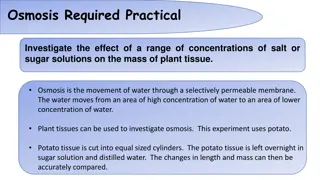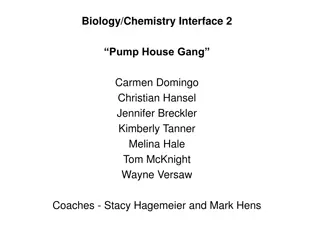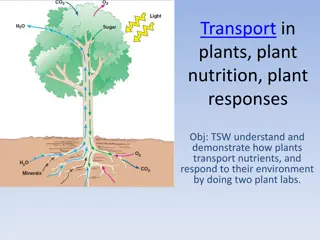Understanding Active Transport and Osmosis in Biology
Substances can be absorbed against concentration gradients through active transport, requiring energy from respiration. Cells use transport proteins to move substances across membranes. Osmosis involves the movement of water across a selectively permeable membrane along concentration gradients. The different effects of osmosis on animal and plant cells are explained, highlighting hypertonic and hypotonic solutions. This process is vital for nutrient absorption in plants and maintaining cell structure in animals.
Download Presentation

Please find below an Image/Link to download the presentation.
The content on the website is provided AS IS for your information and personal use only. It may not be sold, licensed, or shared on other websites without obtaining consent from the author. Download presentation by click this link. If you encounter any issues during the download, it is possible that the publisher has removed the file from their server.
E N D
Presentation Transcript
3.5 Unit 3: Biology 3 B3.1.1 Dissolved Substances Substances are sometimes absorbed against a concentration gradient. This requires the use of energy from respiration. The process is called active transport. Active transport enables cells to absorb ions from very dilute solutions. Active transport allows cells to move substances from an area of low concentration to an area of high concentration. This movement is against a concentration gradient. This enables to cells to move sugars and ions from one place to another through the cell membrane. https://encrypted-tbn2.gstatic.com/images?q=tbn:ANd9GcTMzNFvhyPRqFUGWK7pHMApJwjBuHAK3Wzs6BMYzYQCUjI1efP9pw In the cell membrane are transport proteins or systems. The substrate molecule binds to the transport protein. The transport protein moves across the membrane carrying the substrate to the other side. The substrate is released and the transport protein returns to its original position. This processes uses energy from cellular respiration in the mitochondria. The rate of active transport depends upon the rate of respiration. The higher the rate of respiration the higher the rate of active transport. The importance of Active Transport: In plants: Plants need to move mineral ions from the soil into their roots. Mineral ions are much more concentrated in the cytoplasm of plant cells than in soil water (dilute), so they have to be moved against a concentration gradient. This involves active transport and the use of energy from cellular respiration. Sugars: Glucose is always actively absorbed out of the gut and kidney tubles into the blood.
3.5 Unit 3: Biology 3 B3.1.1 Dissolved Substances Osmosis The net movement of water from an area of high concentration of water (dilute) to an area of low concentration of water (concentrated) - ALONG a concentration gradient through a partially permeable membrane. In cells the cytoplasm is made up of chemicals dissolved in water. The cytoplasm contains a fairly concentrated solution of salts and sugars. Water will move from outside the cell into the cell. Differences in the concentration of solutions inside and outside of a cell cause water to move into or out of the cell by osmosis. Remember: Diffusion refers to any particles Osmosis - refers to water A partially permeable membrane allows small, soluble molecules like water to pass through it freely - but prevents larger molecules from doing so. In a cell, the cell membrane acts as a partially permeable membrane. Osmosis in Animal Cells Osmosis in Plant Cells If a cell has a more dilute solution inside it than outside it, then the overall movement of water is out of the cell. cell has a more concentrated solution inside it than outside it, then the overall movement of water is into the cell If a cell has a more dilute solution inside it than outside it, then the overall movement of water is out of the cell. cell has a more concentrated solution inside it than outside it, then the overall movement of water is into the cell In plant cells this causes the cell to begin to swell, and the cytoplasm and membrane push against the cell wall. The strong cell wall then resists further expansion, supporting the cell which becomes turgid (fully inflated). In plant cells this would cause the membrane and cytoplasm to shrink away from the cell wall, causing the plant cell to become flaccid (limp). Any large movement of water into animal cells causes it to burst Animal Cells Shrink and shrivel
3.5 Unit 3: Biology 3 B3.1.1 Dissolved Substances Water will move from outside the cell into the cell Water will move from inside the cell to outside the cell Hypertonic - higher solute concentration compared with another. For example, if the extracellular fluid has greater amounts of solutes than the cytoplasm, the extracellular fluid is said to be hypertonic. Osmosis in Animal Cells Hypotonic - a solution with a comparatively lower concentration of solutes compared to another Water often moves across boundaries by osmosis. Osmosis if the diffusion of water from a dilute to a more concentrated solution through a partially permeable membrane that allows the passage of water molecules. Osmosis in Plant Cells
Unit 3: Biology 3 B3.1.1 Dissolved substances The villi in the small intestine provide a large surface area with an extensive network of blood capillaries. This makes the villi well adapted to absorb the products of digestion by diffusion and active transport. The villi provide a large surface area with an extensive network of capillaries to absorb the products of digestion by diffusion and active transport. Each villus is covered in many microscopic microvilli. This increases the surface area available for diffusion even more. It is important that the villi has a rich blood supply to absorb and carry dissolved food molecules to the cells of the body to be used during respiration and to maintain a concentration gradient. Glucose is moved from the small intestine into the blood by active transport. The digested food molecules have to move against the concentration gradient. This makes sure that none of the digested food is wasted and lost as faeces. The Villi is a tiny projection of the lining of the small intestine which increase the surface area for the absorption of digested products. Villi are adapted for the maximum absorption of digested food molecules because: 1. the folded villi greatly increase the surface area of the intestine 2. the villi are made of a single layer of thin cells (one cell thick) so there is a short diffusion path 3. beneath the villi is an extensive blood capillary network to distribute the absorbed food molecules. A rich blood supply produces a steep concentration gradient for diffusion. In the wall of the intestine are the villi. The villi make it possible for digested food to be transferred from the intestine into the blood by diffusion or active transport.
3.5 Unit 3: Biology 3 B3.1.1 Dissolved Substances While you exercise, sugars (glucose) is used by the mitochondria of your cells in a process called respiration, to release energy. The water and mineral ions lost by sweating during exercise need to be replaced to avoid dehydration. A sports drink contain: 1. Water 2. Sugar glucose 3. Mineral ions 4. Colourings and flavourings If the sugars, water and mineral ions are not replaced, the mineral ion/water balance of your body is disturbed and your body will not function effectively. Sports drinks contain lots of water, so they dilute the body fluids. This allows water to move back into the cells and rehydrate them by osmosis. Sports drinks contain salt, which raise ions levels, so ions move back into cells by diffusion. They raise the blood sugar levels so sugar move back into cells by diffusion and active transport. Sports drink aid hydration of the tissues, help replace used sugar, lost water and electrolytes the mineral ions lost via sweating. Sports drinks manufacturers often make claims about the performance benefits of using their branded sports drinks, but it is important that these claims are evaluated based on valid data from controlled trials of a large sample of athletes. Different manufacturers put slightly different amounts of sugar and mineral ions in their sports drinks, and therefore each brand will potentially have differing effects on an athlete s performance. Evidence suggests that for normal levels of exercise water is at least as effective as a sports drink. Water, orange squash and salt will replace the most of the important mineral ions. http://t0.gstatic.com/images?q=tbn:ANd9GcTrGIjkv8r8hF6C3H2q0Zw7u9yK0v6aVgTIXUORtOSO1RNl1qxT
Unit 3: Biology 3 B3.1.2 Gaseous Exchange The effectiveness of an exchange surface can be increased by: 1. Having a large surface area 2. Being thin, which provides a short diffusion path 3. Having an efficient blood supply in animals. This moves the diffusing substances away and maintains a concentration (diffusion) gradient. 4. Being ventilated, in animals, to make gaseous exchange more efficient by maintaining steep concentration gradients. The Lungs adapted to make gas exchange more efficient. The lungs are made up of alveoli. Alveoli are tiny air sacs, which give the lungs a very large surface area with a good blood supply and short diffusion distances. The lungs are ventilated to maintain steep diffusion gradients. The capillaries are very thin this allows diffusion to take place over short distances. The membrane are kept moist to allow the gases to dissolve and pass through the membranes. Spherical shape of the alveolus gives a large surface area for diffusion. http://sbi3u1rmcdonald.edublogs.org/files/2010/06/0013n046.jpg Ventilation moves air in and out and maintains a steep diffusion gradient. Thin alveolus walls provide a short diffusion path Blood Supply maintains concentration gradient for diffusion.
Unit 3: Biology 3 B3.1.2 Gaseous Exchange Lungs are located in the thorax and protected by the ribcage. The abdomen is separated by the diaphragm. The digestive organs are located beneath your diaphragm in the abdomen. THORAX The breathing system takes air into and out of the body so that oxygen from the air can diffuse into the bloodstream and carbon dioxide can diffuse out of the bloodstream into the air. ABDOMEN When you exhale: the intercostal muscles relax, the ribcage drops inwards and downwards the diaphragm relaxes, moving back upwards, decreasing the volume of the chest. pressure inside the chest increases and air is forced out. Pressure in the chest higher than outside so air is forced out of the lungs. When you inhale: the intercostal muscles contract, expanding the ribcage. the diaphragm contracts, pulling downwards to increase the volume of the chest. pressure inside the chest is lowered and air is sucked into the lungs. Atmospheric air at high pressure than the chest causes air to be drawn into the lungs LEARN https://moodle.beverleyhigh.net/pluginfile.php/7503/mod_resource/content/0/assets/images/ks4/breathe.gif LEARN
Unit 3: Biology 3 B3.1.2 Gaseous Exchange A person might struggle to breath for the following reasons: 1. The tubes leading to the lungs may be narrow so less air gets through them. 2. The structure of the alveoli can break down. This results in alveoli which have a smaller surface area for gas exchange. 3. Some people are paralysed in an accident or by disease so they can not breathe. Two main ways: Negative Pressure and Positive Pressure for supporting or taking over breathing, to save lives. Positive Pressure: Air is forced into the lungs through a tube which is inserted into the trachea. As the ventilator pumps air in, the lungs inflate. When the ventilator stops, the elasticity of the lungs, diaphragm and chest wall cause exhalation. Can be using a simple face mask or a tube going into the trachea. Patients do not have to be placed into a machine. The equipment can be used at home. The patient can move about. Patient has control over the machine. Computer systems can be linked to help monitor the patients breathing. Negative Pressure: Iron Lung An external negative pressure ventilator patients whole body is put into a machine. The patient is placed in an airtight machine from the neck down, and a vacuum is created around the thorax. This creates a negative pressure, which leads to the expansion of the thorax and a decrease in pressure. As a result, air is drawn into the lungs. As the vacuum is released, the elasticity of the lungs, diaphragm and chest wall cause exhalation. Advantages Disadvantage Negative Pressure (Developed and used from the 1920s to treat polio sufferers) Effective at treating many polio patients over the years Patient is confined to the machine The vacuum on full-body machines can affect the abdomen, leading to the pooling of blood in lower parts of the body Positive Pressure (Used extensively since the 1950s) Useful during operations, where surgeons need access to the body Effective at ventilating the lungs Long-term ventilation requires the tube to be surgically inserted into the trachea through the neck
Unit 3: Biology 3 B3.1.3 Exchange Systems in Plants 1. The surface area of the roots is increased by root hairs and the surface area of leaves is increased by the flattened shape and internal air spaces. Plants have stomata to obtain carbon dioxide from the atmosphere and to remove oxygen produced in photosynthesis. Plants mainly lose water vapour from their leaves. Most of the loss of water vapour takes place through the stomata. The size of stomata is controlled by guard cells, which surround them. 1. Carbon dioxide enters the leaf cells by diffusion through stomata. Water and mineral ions are absorbed by root hair cells Carbon dioxide and Water is used during photosynthesis Root hair cells increase the surface area of the roots and the flattened shape and internal air spaces increase the surface of the leaves. The flattened shape of the leaves increase the surface are for diffusion as the diffusion path is kept short. The internal air spaces allow carbon dioxide to come into contact with lots of cells giving it a large surface area. Osmosis is used to take water from the soil Active transport is used to obtain ions from the soil. Leaves are adapted to allow carbon dioxide in only when it is needed. They are covered with a waxy cutilce. Which is a waterproof and gas proof layer. 2. 2. 3. 4. 3. 4. 5. When it is dark photosynthesis will not occur. Therefore carbon dioxide is not required. The carbon dioxide produced by respiration is available for the plant to use. Only on a bright, sunny days a lot of carbon dioxide needs to come into the leaves by diffusion. 6. 7. 8. http://www.doctortee.com/dsu/tiftickjian/cse-img/botany/plant-phys/stoma-mechanism.jpg Stomata (stoma) can be opened when the plant needs to allow carbon dioxide into the leaves. Oxygen produced by photosynthesis is able to leave the plant by diffusion. The opening and closing of the stoma are controlled by guard cells (eg they close the stomata to prevent wilting). Water is lost from the leaves by diffusion when the stoma are opened. http://www.bbc.co.uk/schools/gcsebitesize/science/images/bi05004.gif The guard cells open and close the stomata depending upon the amount of potassium ions present in the fluid in the cell. The more potassium ions that are present, the more the cells become turgid (swollen) and the bigger the opening. The size of the opening is used by the plant to control the rate of transpiration and therefore limit the levels of moisture in the leaf which prevents it from wilting.
Unit 3: Biology 3 B3.1.3 Exchange Systems in Plants The mineral ions are transported around the plant where they serve a variety of functions, whilst the water is transported to be used as a reactant in photosynthesis, as well as to cool the leaves by evaporation and support the leaves and shoots by keeping cells rigid. Roots absorb water from the soil by osmosis and dissolve mineral ions from the soil by active transport. Plant roots are thin, divided structures with a large surface area. The cells on the outside of the roots near the growing tips also have extensions, called root hairs, which increase the surface area for the uptake of substances from the soil. These tiny projections from the cells push out between the soil particles. The membranes of the root hair cells also have microvilli that increase the surface area for diffusion and osmosis even more. The water then has only a short distance to move across the root to the xylem, where it is moved up and around the plant. To maximise the efficiency of absorption, roots have specialised cells called root hair cells which are found just behind the tip of the root. Root hair cells have several adaptations: 1. the tube-like protrusion provides a greater surface area across which water and mineral ions can be exchanged 2. the tube-like protrusion can penetrate between soil particles, reducing the distance across which water and mineral ions must move 3. the root hair cell contains lots of mitochondria, which release energy from glucose during respiration in order to provide the energy needed for active transport http://t1.gstatic.com/images?q=tbn:ANd9GcQ7jjic3pTUuiaZVd3WIlri7PvhSw7MtBzQ0amGiqftqsgHlTgLIw Root Root Hairs - increase the surface area for the uptake of substances from the soil. The membranes of the root hair cells also have microvilli that increase the surface area for diffusion and osmosis even more.
Unit 3: Biology 3 B3.1.3 Exchange Systems in Plants Transpiration is the loss of water vapour from the surface of plant leaves through the stomata. Water evaporates from the surface of the leaves, through the open stomata. As this water evaporates, water is pulled up through the xylem to take its place. This constant moving of water through the xylem from the roots to the leaves is known as the transpiration stream. Water moves into the roots from the soil by osmosis. It replaces the water constantly moving up the stem. Water moves up from the roots into the stem. Water moves up through the stem and into he leaves to replace the water lost by evaporation. Water is lost from the leaves by evaporation through open stomata. When the stomata are open more carbon dioxide enters the leaf. This increases the rate of photosynthesis. In turn, this also increases the rate of transpiration, as more water is lost by evaporation through the open stomata. https://encrypted-tbn2.gstatic.com/images?q=tbn:ANd9GcRdTpRzw0Di5QiWn4cMYeB2A8LGWcpHYrU72ap7dyjVlooAofhh So factors which increase the rate of photosynthesis and the rate of evaporation also increased the rate of transpiration. The factors include: Warm, Sunny, Hot, Dry and Windy Conditions Controlling water loss: 1. Cuticle Waterproof Waxy Layer prevent uncontrolled water loss. 2. Stomata found on the underside of the leaves. This protects them from direct sunlight and reduces the time they are open. Stomata close, which stops photosynthesis and risks overheating. 3. Wilting When a plant begins to lose water faster than it is being replaced by the roots. The leaves collapse and hang down. The surface area available for water loss by evaporation is greatly reduced. The plant will remain wilted until the Sun goes in or it rains.
Unit 3: Biology 3 B3.1.3 Exchange Systems in Plants Terms to Learn Diffusion - the net movement of particles of a gas or a solute from an area of high concentration to an area of low concentration ALONG a concentration gradient. Through a partially permeable membrane. Osmosis The net movement of water from an area of high concentration of water (dilute) to an area of low concentration of water (concentrated) - ALONG a concentration gradient. Through a partially permeable membrane Active Transport - the movement of substances AGAINST a concentration gradient and /or across a cell membrane, using energy. Partially permeable membrane - allowing only certain substances to pass through Transpiration The loss of water vapour from the leaves of plants through stomata when they are open to allow gas exchange for photosynthesis. Transpiration Stream The movement of water through a plant from the roots to the leaves as a result of loss of water by evaporation from the surface of the leaves.























